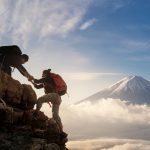Mountain Fuji Climbing Experience
Climbling is the best option to enjoy the beauty of Mt. Fuji. So, what do you need to prepare before deciding to climb Mt. Fuji? Here are the climbing experiences of Mt. Fuji that Focus Asia Travel would like to share with you!
About Mt. Fuji

Mount Fuji
Anyone who loves Japan will know Mt. Fuji, a symbol of the land of the rising sun. With a height of 3776 meters above sea level. Mt. Fuji is the 2nd highest mountain in Asia and the 7th highest in the entire world. In particular, in 2013, UNESCO designated Mt. Fuji as one of the World Heritage Sites, which futher enhances its status.
Not only is Mt. Fuji a cultural symbol, but it is also a favorite destination for domestic and foreign tourists because it is only about 100km from Tokyo, about 1 hour by shinkansen or 2 hours and 15 minutes by JR bus. Therefore, it is always an ideal place for tourists visiting the Tokyo or Kanto area, Japan.
The right time to climb
The climbing season for Mt. Fuji usually starts from early July to mid-September, depending on the weather every year. In other months, because the weather is often bad and dangerous for climbers, Mt. Fuji will be closed.
Mt. Fuji hiking trails
Mt. Fuji has a total of 4 hiking trails: Yoshida, Subashiri, Gotemba, and Fujinomiya, each with 10 rest stops. In particular, Yoshida is the most popular route for many people due to its ease of travel and also many rest stops with utilities such as paid toilets, food, water, climbing gear, and oxygen tanks. Yoshida Street will be open from July 1 to September 10, and the other three will be open from July 10 to Semtember 10.

Tourists experience climbing mountain Fuji, Japan. Photo: Unsplash
The climbing time will vary depending on the route, but on average it will take you 1-2 days to complete the journey (both up and down). Most climbers recommend only climbing to station 7 or 8 and sleeping there on the first day before continuing the climb the next day. Thus, your body will have time to adapt to the altitude and density of the air above the shift.
Physical Fitness
Besides, you should also exercise your physical strength, especially in the legs, before climbing. Thermos, hiking shoses, food, drinking water (at least 2 liters), and cash are indispensable items in luggage, In addition, you can also bring a raincoat, a flashlight worn on your forehead, and a hiking stick to make your journey easier.
Althought it is mentioned above that each climbing route consists of 10 rest stops, you don’t need to climb all 10 of these stops? Currently, there are train/bus services that take you directly to station 5, which shortens the distance quite a lot. The most famous is undoubtedly the Fuji Subaru No. 5 rest stop on the Yoshida route. Climbers can buy additional necessary items, such as climbing poles, snacks, oxygen cylinders,… here before staring the journey. It also has parking lots, lockets, restaurants, and other shops.
Even if you don’t plan to climb any further, Fuji Subaru Station is a must-visit when you come to Mt. Fuji Located at an altitude of 2300 meters above sea level, from Fuji Subaru Station, you can enjoy a panoramic view of the Five Lakes surrounding Mt. Fuji.
Wish you have a memorable Mountain Fuji Climbing Experience!
>> See more: Explore 10 best tourist attraction in Kyoto











